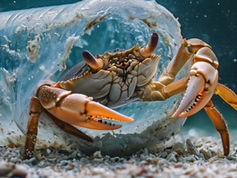Search
Color-Changing Animals
- Lauren A. Moe
- Feb 20, 2024
- 2 min read
Updated: Apr 9, 2024
Nearly all animals have evolved with some form of camouflage, and many depend upon such skills for survival. However, only a few animals can change color in a matter of seconds… so how do they do it?
The ability to quickly change skin color comes from the presence of specialized cells called chromatophores. These cells are unique to ectotherms (animals that cannot control their own body heat), such as squid, octopuses, cuttlefish, and the notably color-changing chameleon. Humans are endotherms, meaning we generate and control our body’s internal temperature. While this is good news for our survival, it sadly means we do not possess chromatophores, and therefore cannot turn our skin all colors of the rainbow.
Chromatophores contain color pigment that can be red, orange, yellow, brown, or black, and they work by stretching out and condensing on the skin. Imagine a clear balloon full of water and red ink- when the balloon is relaxed, the ink is concentrated in the center making the balloon appear dark. If you were to stretch or flatten the balloon out, the ink would spread out and become a much lighter shade (as seen in the image below). Pigmented chromatophores act like millions of little balloons covering the surface of these animals, each one able to adjust for vivid color displays.







Comments